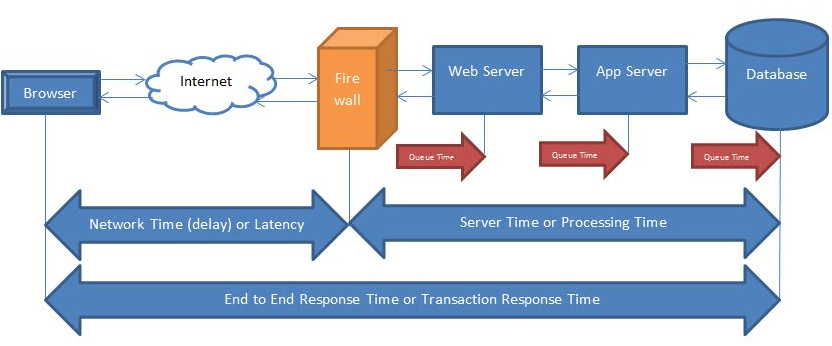Response time refers to the time that elapses between when a user hits a button on the webpage and the full data received from the server at his end. This is also called End-to-End response time. As a performance tester, you can see response time as a single unit. But the response time figure is the summation of many other small units or individual responses. A performance tester may ignore the component level response time, but for a performance engineer, it is a must to understand, analyse and tune the component level response time to optimise the End-to-End response time. Let’s try to understand what does come under a simple ‘Response Time’.
Refer to the below GIF, the moment you click the ‘PERFOWLEDGE’ tab till the response arrives to load the page is the response time of the PERFOWLEDGE page. The response time is 1.2 seconds.

The overall response time of a web request comprises of:
- Network Delay
- Server Processing Time
Refer to the below figure:

Network Time (delay) or Latency:
Network Time (or delay) refers to the time taken by a communication channel (network) to send a request from the client to the server and the server to the client. Let’s say a request takes 0.2 sec to travel from the client end to the server end and its response takes 0.22 sec to travel from the server to the client end then the total Network Time or Delay is 0.42 sec (=0.2 + 0.22). Network delay can be further divided into several parts:
- Nodal Processing delay: The time that routers take to process the packet header
- Queuing delay: The time that the packet spends in routing queues
- Transmission delay: The time that a router takes to push the packet’s bits onto the link
- Propagation delay: The time required for a signal to reach its destination
Server Time:
The time that a server takes to process a request is called Server Time or Processing Time. The total server time is the summation of individual server responses (Web, App, DB etc.) and queue time.
- Queue Time: When a request arrives at a busy resource and cannot be serviced immediately and the request is queued then requests are subject to a queue time delay once they begin to wait in a queue before being serviced.
What is Average Response Time?
Let’s say you ran a test with 5 Virtual Users and got the below response time for Home Page:
1st Vuser has a response time of 1 sec for the Home Page
2nd………………………………….2 secs …………………
3rd………………………………….3 secs …………………
4th…………………………………..4 secs …………………
5th…………………………………..5 secs …………………
So, the average response time of the Home Page request is (1 + 2 + 3 + 4 + 5)/5 = 3 secs. Hence the average response time is the average of all the responses for a particular request sent by a given number of Vusers.
You may be interested:

